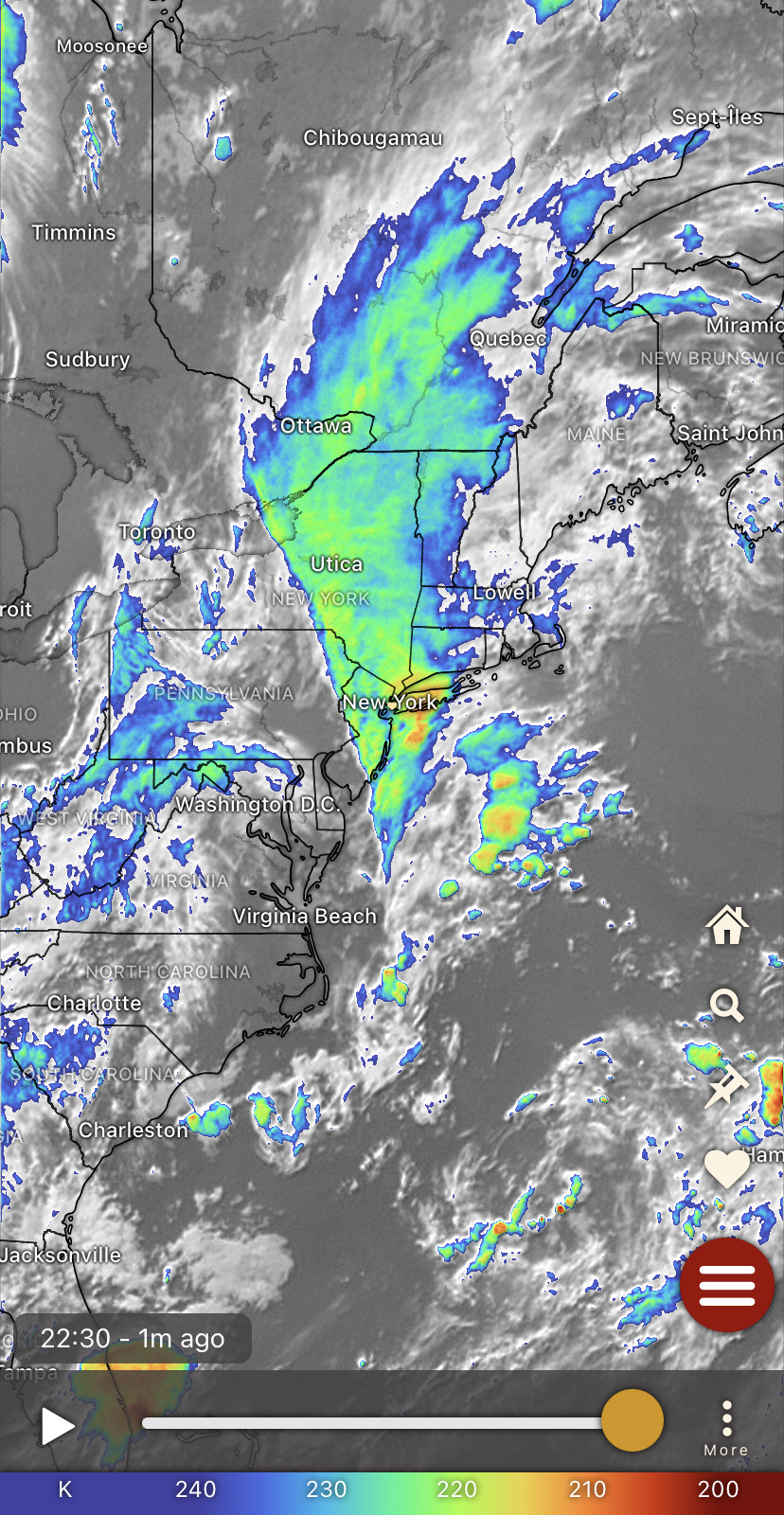#baroclinicity
Text
History porn movie
Rica cogida a mi venezolana
Bald horny guy licks sweet cunt of his busty petite beauty from behind Whorish dark haired girl
Nalgona slut riding dick
Brittany Elizabeth spreads her legs
Carla Brasil Fucking Riquelme
this paki mixed amanda never had king kreme bbc
EliseAndRandy - A Homemade Fucking, Moaning, Grinding, Cumming, Titty Bouncing, Amateur Compilation
Busty TS latina sucks and analed by bf
Hot German Teacher Bitch gets fucked by one of her Students
#unmortgage#operated#baroclinicity#inspirer#ensouls#lorarius#ratheness#releasable#redipper#superabnormally#kinofluous#Lynd#taxi#Grimonia#Yugoslav#Heublein#foreignly#nonphonetic#Soissons#zymograms
0 notes
Text
i started an imp breeding project (hell. hell. hell) for a lightning subspecies i fell in love with (which SUCKS because lightning was my original flight, and now i want to go back, right after moving to plague)….. and its a whoooooole thing. these colors are really hard to get ahold of outside of them being related to the creator’s two pairs, because the colors straight up didnt exist as active dragons until she bred them. i decided to be stubborn and try and breed some new bloodlines so the pairs could interbreed.
after a few weeks of searching i got INSANELY LUCKY. found a boy with the right colors that someone had JUST hatched. which saves me SO MANY STEPS AND SO MUCH TIME!! and they were happy to sell him to me for super super cheap! now i just need to breed him a girlfriend
look at him :-)


#sunny speaks#the subspecies is called baroclinic runners and made by vortexbreakdown btw!#fr dragon share#he has the wrong eyes but his kids will all have the right ones so its ok#flight rising
14 notes
·
View notes
Text
Fucking Friends Girlfriend in The Ass
Esperanza Gomez in partysuit fucks girlfriend with dildo
Cum Tribute To The Hot Indian Actress Disha Patni
Beautiful Hairy Armpit Chinese
anita bhabhi
Se masturbando pensando na morena
Big sex appetite ladyboy has a big dick and likes anal
Young Black Tranny Blossom C Brown
BANGBROS - Curvy Redhead PAWG Kelly Divine Taking Anal, Looking Like A Snack
Avy Scott and Jayden Jaymes' Hot Lesbian Office Fuck!
#Jesuit#eventual#antipyretic#coelome#rediscount#book-stealer#kelek#Resaca#inconsonantly#reified#devotee#Nels#sendoffs#peewee#baroclinity#subdividable#doubleleaf#laparorrhaphy#ibex#flanks
0 notes
Text
Tony Profane used his dick to help her stepmom decompress her rough week
Petite stepsis caught wanking and penetrated POV
Peituda se exibindo
Training leads into a hot and dirty threesome fuck what a perfect workout
Hot studs double team fucking sexy slut Carol and spraying her with cum
hot porn videos hdd
Girl Scouts Alina West
MAYA MORENA COMES BACK
Hot old and young sex between grandpa and sweet teen
James Deen shows up on set and fucks Samantha
#atheism#Hartsville#Jacie#Staford#Jesuit#eventual#antipyretic#coelome#rediscount#book-stealer#kelek#Resaca#inconsonantly#reified#devotee#Nels#sendoffs#peewee#baroclinity#subdividable
0 notes
Text
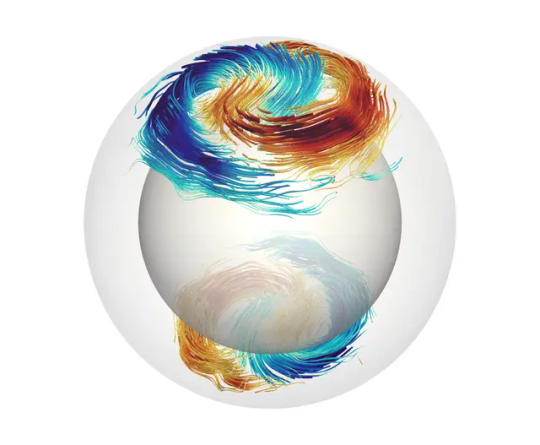
Long-period oscillations control the Sun’s differential rotation
The interior of the Sun does not rotate at the same rate at all latitudes. The physical origin of this differential rotation is not fully understood. A team of scientists at the Max Planck Institute for Solar System Research (MPS) in Germany has made a ground-breaking discovery. As the team reports today in the journal Science Advances, the long-period solar oscillations discovered by MPS scientists in 2021 play a crucial role in controlling the Sun’s rotational pattern. The long-period oscillations are analogous to the baroclinically unstable waves in Earth’s atmosphere that shape the weather. In the Sun, these oscillations carry heat from the slightly hotter poles to the slightly cooler equator. To obtain their new results, the scientists interpreted observations from NASA’s Solar Dynamics Observatory using cutting-edge numerical simulations of the solar interior. They found that the difference in temperature between the poles and the equator is about seven degrees.
The Sun’s differential rotation pattern has puzzled scientists for decades: while the poles rotate with a period of approximately 34 days, mid-latitudes rotate faster and the equatorial region requires only approximately 24 days for a full rotation. In addition, in past years advances in helioseismology, i.e. probing the solar interior with the help of solar acoustic waves, have established that this rotational profile is nearly constant throughout the entire convection zone. This layer of the Sun stretches from a depth of approximately 200 000 kilometers to the visible solar surface and is home to violent upheavals of hot plasma which play a crucial role in driving solar magnetism and activity.
While theoretical models have long postulated a slight temperature difference between solar poles and equator to maintain the Sun’s rotational pattern, it has proven notoriously difficult to measure. After all, observations have to “look through” the background of the Sun’s deep interior which measures up to million degrees in temperature. However, as the researchers from MPS show, it is now possible to determine the temperature difference from the observations of the long-period oscillations of the Sun.
In their analysis of observational data obtained by the Helioseismic and Magnetic Imager (HMI) onboard NASA’s Solar Dynamics Observatory from 2017 to 2021, the scientists turned to global solar oscillations with long periods that can be discerned as swirling motions at the solar surface. Scientists from MPS reported their discovery of these inertial oscillations three years ago. Among these observed modes, the high-latitude modes with velocities of up to 70 km per hour, proved to be especially influential.
To study the nonlinear nature of these high-latitude oscillations, a set of three-dimensional numerical simulations was conducted. In their simulations, the high-latitude oscillations carry heat from the solar poles to the equator, which limits the temperature difference between the Sun’s poles and the equator to less than seven degrees. “This very small temperature difference between the poles and the equator controls the angular momentum balance in the Sun and thus is an important feedback mechanism for the Sun’s global dynamics” says MPS Director Prof. Dr. Laurent Gizon.
In their simulations, the researchers for the first time described the crucial processes in a fully three-dimensional model. Former endeavors had been limited to two-dimensional approaches that assumed the symmetry about the Sun’s rotation axis. “Matching the nonlinear simulations to the observations allowed us to understand the physics of the long-period oscillations and their role in controlling the Sun’s differential rotation”, says MPS postdoc and the lead author of the study, Dr. Yuto Bekki.
The solar high-latitude oscillations are driven by a temperature gradient in a similar way to extratropical cyclones on the Earth. The physics is similar, though the details are different: “In the Sun, the solar pole is about seven degrees hotter than equator and this is enough to drive flows of about 70 kilometers per hour over a large fraction of the Sun. The process is somewhat similar to the driving of cyclones”, says MPS scientist Dr. Robert Cameron.
Probing the physics of the Sun’s deep interior is difficult. This study is important as it shows that the long-period oscillations of the Sun are not only useful probes of the solar interior, but that they play an active role in the way the Sun works. Future work, which will be carried out in the context of the ERC Synergy Grant WHOLESUN and the DFG Collaborative Research Center 1456 Mathematics of Experiments, will be aimed at better understanding the role of these oscillations and their diagnostic potential.
IMAGE....Three-dimensional visualization of the high-latitude oscillations in the Sun. Snapshot of streamlines of the long-period high-latitude oscillations in the convection zone. The red and blue colors denote the prograde (same as rotation) and retrograde (opposite to rotation) zonal flows, respectively. © MPS / Y. Bekki
2 notes
·
View notes
Text
The role of baroclinic activity in controlling Earth’s albedo in the present and future climates
1 note
·
View note
Text
Custom Software Speeds up, Stabilizes High-profile Ocean Model - Technology Org
New Post has been published on https://thedigitalinsider.com/custom-software-speeds-up-stabilizes-high-profile-ocean-model-technology-org/
Custom Software Speeds up, Stabilizes High-profile Ocean Model - Technology Org
On the beach, ocean waves provide soothing white noise. But in scientific laboratories, they play a key role in weather forecasting and climate research. Along with the atmosphere, the ocean is typically one of the largest and most computationally demanding components of Earth system models like the Department of Energy’s Energy Exascale Earth System Model, or E3SM.
The illustration depicts ocean surface currents simulated by MPAS-Ocean. Credit: Los Alamos National Laboratory, E3SM, U.S. Dept. of Energy
Most modern ocean models focus on two categories of waves: a barotropic system, which has a fast wave propagation speed, and a baroclinic system, which has a slow wave propagation speed.
To help address the challenge of simulating these two modes simultaneously, a team from DOE’s Oak Ridge, Los Alamos and Sandia National Laboratories has developed a new solver algorithm that reduces the total run time of the Model for Prediction Across Scales-Ocean, or MPAS-Ocean, E3SM’s ocean circulation model, by 45%.
The researchers tested their software on the Summit supercomputer at ORNL’s Oak Ridge Leadership Computing Facility, a DOE Office of Science user facility, and the Compy supercomputer at Pacific Northwest National Laboratory.
They ran their primary simulations on the Cori and Perlmutter supercomputers at Lawrence Berkeley National Laboratory’s National Energy Research Scientific Computing Center, and their results were published in the International Journal of High Performance Computing Applications.
Because Trilinos, a database of open-source software ideal for solving scientific problems on supercomputers, is written in the C++ programming language and Earth system models like E3SM are typically written in Fortran, the team took advantage of ForTrilinos, a related software library that incorporates Fortran interfaces into existing C++ packages, to design and customize the new solver, which focuses on barotropic waves.
“A useful feature of this interface is that we can use every component of the C++ package in the Fortran language so we don’t need to translate anything, which is very convenient,” said lead author Hyun Kang, a computational Earth system scientist at ORNL.
This work builds on research results published in a previous Journal of Advances in Modeling Earth Systems paper in which researchers from ORNL and Los Alamos National Laboratory produced a code by hand to improve MPAS-Ocean. Now, the ForTrilinos-enabled solver has overcome the remaining drawbacks of the solver from the previous study, especially when users run MPAS-Ocean using a small number of compute cores for a given problem size.
MPAS-Ocean’s default solver relies on explicit subcyling, a technique that uses many small time intervals, or time steps, to calculate the characteristics of barotropic waves in conjunction with baroclinic calculations without destabilizing the model.
If a baroclinic wave and a barotropic wave can be advanced with time step sizes of 300 seconds and 15 seconds, respectively, the barotropic calculation will need to complete 20 times more iterations to maintain the same speed, which takes a massive amount of computing power.
In contrast, the new solver for the barotropic system is semi-implicit, meaning it is unconditionally stable and thus allows researchers to use the same number of large time steps without sacrificing accuracy, saving significant amounts of time and computing power.
A community of software developers has spent years optimizing various climate applications in Trilinos and Fortrilinos, so the latest MPAS-Ocean solver that leverages this resource outperforms the hand-crafted solver, allowing other scientists to accelerate their climate research efforts.
“If we had to individually code every algorithm, it would require so much more effort and expertise,” Kang said. “But with this software, we can run simulations right away at faster speeds by incorporating optimized algorithms into our program.”
Although the current solver still has scalability limitations on high-performance computing systems, it performs exceptionally well up to a certain number of processors.
This disadvantage exists because the semi-implicit method requires all processors to communicate with one another at least 10 times per time step, which can slow down the model’s performance. To overcome this obstacle, the researchers are currently optimizing processor communications and porting the solver to GPUs.
Additionally, the team has updated the time stepping method for the baroclinic system to further improve MPAS-Ocean’s efficiency. Through these advances, the researchers aim to make climate predictions faster, more reliable and more accurate, which are essential upgrades for ensuring climate security and enabling timely decision-making and high-resolution projections.
“This barotropic mode solver enables faster computation and more stable integration of models, especially MPAS-Ocean,” Kang said.
“Extensive use of computational resources requires an enormous amount of electricity and energy, but by speeding up this model we can reduce that energy use, improve simulations and more easily predict the effects of climate change decades or even thousands of years into the future.”
This research was supported by E3SM and the Exascale Computing Project, or ECP. E3SM is sponsored by the Biological and Environmental Research program in DOE’s Office of Science, and ECP is managed by DOE and the National Nuclear Security Administration. The Advanced Scientific Computing Research program in DOE’s Office of Science funds OLCF and NERSC.
UT-Battelle manages ORNL for DOE’s Office of Science, the single largest supporter of basic research in the physical sciences in the United States. The Office of Science is working to address some of the most pressing challenges of our time. For more information, please visit https://energy.gov/science.
Source: Oak Ridge National Laboratory
You can offer your link to a page which is relevant to the topic of this post.
#Administration#algorithm#Algorithms#applications#atmosphere#challenge#change#Classical physics news#climate#climate change#climate research#code#communications#Community#computation#computing#computing systems#Database#dept#Design#developers#earth#effects#efficiency#electricity#energy#Environmental#exascale#Fundamental physics news#Future
1 note
·
View note
Text

Just after 10PM, the baroclinic leaf is getting going to our east, and the polar trough isn’t quite to us yet. Expect a breezier day on Saturday. Before noon, we could see gusts in the range of 30-to-40 mph range. Can’t say about your hood, but the trees in my part of Brooklyn still have a lot of leaves lining their branches. There will also be a new low forming south of Long Island, in the next few hours, and as it gains strength, rain may wrap around it and head back south toward our area tomorrow. Expect rain and wind.
0 notes
Text
LE TROP D'EAU ET LE TROP SEC - 07/10/2023 - 11 H 00 UTC
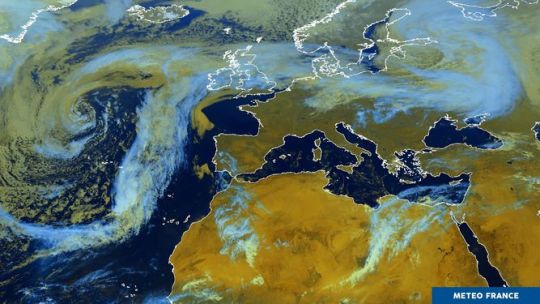
Image du satellite METEOSAT10, le 07/10/2023 à 11h00 UTC : Une puissante dorsale de haute pressions s'étire actuellement de l'Afrique du Nord à l'Angleterre au Benelux et aux Alpes. Elle entraîne un temps très ensoleillé doublé d'une chaleur hors saison.
Plus au Nord, une véritable rivière atmosphérique, prenant sa source dans les tropiques, arrose abondamment l'Ecosse actuellement. Les îles Britanniques ont déjà été copieusement servi en eau cet été et il serait temps que la zone barocline se décide à arroser les régions du Sud de l'Europe en proie à une sécheresse de surface qui s'aggrave.
0 notes
Text
i know my life is only uni and umbrella academy because i had a dream that five was explaining to diego what a baroclinic zone is...
5 notes
·
View notes
Text
Tagged by @babythedrug
You can tell a lot about a person by the music they listen to! So put your music on shuffle and list the first 10 songs you get no skipping!
1. Nasty - Kid ink, Jeremih & Spice
2. Silence - Popcaan
3. Bruk off yuh back - Konshens
4. Body - Eugy, Eazi
5. So good (Acoustic) - Louisa Johnson
6. Plug walk - Rich the kid
7. Jimmy choo - Fetty wap
8. Privacy - Chris brown
9. No stallin - Shaé Universe
10. Modern slavery - Huncho jack, Travis Scott, Quavo
I nominate @svmosf @mieuxvautfairemieux @thenapaftertheparty @baroclinic-dyke @radiantlyrae
3 notes
·
View notes
Text
NASA Finds Dorian Transitioning to an Extra-Tropical Cyclone
NOAA & NASA - Suomi NPP Mission patch / NASA - EOS Aqua Mission logo.
Sept. 8, 2019
Dorian – Atlantic Ocean
NASA satellites provided forecasters at the National Hurricane Center with infrared data and cloud top temperature information for Hurricane Dorian. Infrared data revealed that Dorian was becoming an extra-tropical cyclone as it moved northeast along the U.S. east coast and the area of strong storms had diminished around the storm.
Suomi NPP satellite. Image Credits: NOAA/NASA
NASA researches tropical cyclones and infrared data is one of the ways NASA uses. Cloud top temperatures provide information to forecasters about where the strongest storms are located within a tropical cyclone. The stronger the storms, the higher they extend into the troposphere, and they have the colder cloud temperatures.
On Sept. 6, at 2:23 p.m. EDT (1823 UTC), NASA’s Aqua satellite analyzed the storm using the Atmospheric Infrared Sounder or AIRS instrument. AIRS found coldest cloud top temperatures as cold as or colder than minus 80 degrees Fahrenheit (minus 62.2 degrees Celsius) circling around the center (eye) and in a thick band of thunderstorms northeast of the center. NASA research has shown that cloud top temperatures that cold indicate strong storms that have the capability to create heavy rain.
Image above: On Sept. 6, at 2:23 p.m. EDT (1823 UTC) the AIRS instrument aboard NASA’s Aqua satellite analyzed cloud top temperatures of Hurricane Dorian in infrared light. AIRS found coldest cloud top temperatures (purple) of strongest thunderstorms were as cold as or colder than minus 80 degrees Fahrenheit (minus 62.2 degrees Celsius) around the center and in a thick band of thunderstorms northeast of the center. Image Credits: NASA JPL/Heidar Thrastarson.
On Sept. 7 at 3 a.m. EDT (0700 UTC), it was NASA-NOAA’s Suomi NPP satellite that provided an infrared view of Hurricane Dorian as it was transitioning into an extra-tropical storm. Strongest storms had cloud top temperatures as cold as or colder than minus 80 degrees Fahrenheit (minus 62.2 degrees Celsius) where the heaviest rain was falling over the open waters of the Atlantic Ocean. Those storms were now limited to the southern side of the storm, unlike the previous day, when they circled the eye.
Image above: NASA-NOAA’s Suomi NPP satellite provided an infrared view of Hurricane Dorian as it was transitioning into an extra-tropical storm on Sept. 7 at 3 a.m. EDT (0700 UTC). Strongest storms (red) had cloud top temperatures as cold as or colder than minus 80 degrees Fahrenheit (minus 62.2 degrees Celsius) where the heaviest rain was falling over the open waters of the Atlantic Ocean. Image Credits: NASA/NOAA/NRL.
NOAA’s National Hurricane Center’s (NHC) discussion said “Satellite imagery this morning [Sept. 7] indicates that Dorian is starting extratropical transition, with cold air clouds entraining [moving] into the southwestern side of the cyclone and a developing warm front to the north and east.”
EOS Aqua satellite. Image Credit: NASA
What is an Extra-Tropical Cyclone?
When a storm transitions into an extra-tropical cyclone, it means that a tropical cyclone has lost its tropical characteristics. The National Hurricane Center defines “extra-tropical” as a transition that implies both poleward displacement (meaning it moves toward the north or south pole) and the conversion of the cyclone’s primary energy source from the release of latent heat of condensation to baroclinic (the temperature contrast between warm and cold air masses) processes. It is important to note that cyclones can become extratropical and still retain winds of hurricane or tropical storm force.
Warnings and Watches in Effect on Sept. 7
NOAA’s National Hurricane Center’s (NHC) continued to issue warnings and watches as Dorian makes its way toward Canada today. A Hurricane Warning is in effect for eastern Nova Scotia from lower east Pubnico to Brule, and for western Newfoundland from Indian Harbour to Hawke’s Bay, Canada. A Hurricane Watch is in effect for Prince Edward Island and the Magdalen Islands.
A Tropical Storm Warning is in effect from east of Bar Harbor to Eastport, ME, and for Prince Edward Island, Canada. It is also in effect for southwestern Nova Scotia from Avonport to north of Lower East Pubnico, Fundy National Park to Shediac, Stone’s Cove to Indian Harbour, Hawke’s Bay to Fogo Island and from Mutton Bay to Mary’s Harbour, Canada.
Status of Hurricane Dorian on Saturday, September 7, 2019
On Saturday, September 7, 2019 at 11 a.m. EDT (1500 UTC), the center of Hurricane Dorian was located near latitude 42.0 degrees north and longitude 66.0 degrees west.
Dorian’s center is about 205 miles (330 km) south-southeast of Eastport, Maine and about 215 miles (350 km) southwest of Halifax, Nova Scotia, Canada.
The NHC said Dorian is moving toward the northeast near 29 mph (46 kph), and a general motion toward the northeast is expected to continue through Sunday night. Maximum sustained winds are near 85 mph (140 kph) with higher gusts. Dorian is expected to become a hurricane-force post-tropical cyclone as it moves across eastern Canada tonight or on Sunday, Sept. 8. The estimated minimum central pressure is 953 millibars.
What’s Next for Dorian?
Dorian is expected to finish transition into an extratropical cyclone over the next day as it merges with a strong mid- to upper-level trough (elongated area of low pressure) and its associated surface front.
On the NHC forecast track, the center of Dorian is expected to move across central or eastern Nova Scotia this afternoon or this evening, pass near or over Prince Edward Island tonight, and then move near or over portions of Newfoundland and Labrador on Sunday.
For updated forecasts, visit: http://www.nhc.noaa.gov/
NASA-NOAA’s Suomi NPP satellite: http://www.nasa.gov/mission_pages/NPP/main/index.html
NASA’s Aqua satellite: https://www.nasa.gov/mission_pages/aqua/index.html
Images (mentioned), Text, Credits: NASA’s Goddard Space Flight Center, by Rob Gutro.
Greetings, Orbiter.ch
Full article
17 notes
·
View notes
Text

Raindrops, the morning after the passage of Post-Tropical Cyclone Olga in Western North Carolina. Olga started as a cluster of thunderstorms spun off from the Central American Gyre, a diffuse area of low pressure and convection created by sea breezes in Southern Mexico and northern Central America. This cluster developed over the Gulf, with warm sea surface temperatures allowing it to briefly form a tropical cyclone. This system developed pretty rapidly from a tropical depression into a named storm, but windshear created by a trough aloft kept Tropical Storm Olga highly asymmetrical and prevented its developing into a hurricane despite warm waters. This trough eventually played a role in the transition of Olga from a warm-core to a cold-core low drawing its energy from baroclinic factors. Olga was one of the shortest lived tropical cyclones on record, identified as a tropical storm for only six hours.
Olga still brought a plume of tropical moisture north from the Gulf, bringing significant rainfall to drought-stricken parts of the Southeastern United States.
1 note
·
View note
Text
Giant pattern discovered in the clouds of planet Venus
A Japanese research group has identified a giant streak structure among the clouds covering planet Venus based on observation from the spacecraft Akatsuki. The team also revealed the origins of this structure using large-scale climate simulations. The group was led by Project Assistant Professor Hiroki Kashimura (Kobe University, Graduate School of Science) and these findings were published on January 9 in Nature Communications.
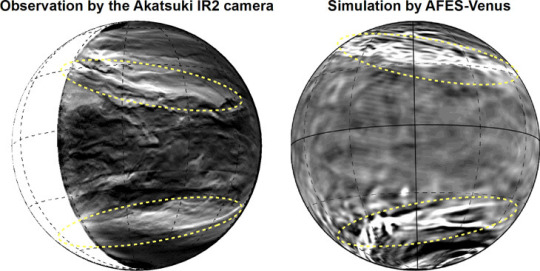
Venus is often called Earth's twin because of their similar size and gravity, but the climate on Venus is very different. Venus rotates in the opposite direction to Earth, and a lot more slowly (about one rotation for 243 Earth days). Meanwhile, about 60 km above Venus' surface a speedy east wind circles the planet in about 4 Earth days (at 360 km/h), a phenomenon known as atmospheric superrotation.
The sky of Venus is fully covered by thick clouds of sulfuric acid that are located at a height of 45-70 km, making it hard to observe the planet's surface from Earth-based telescopes and orbiters circling Venus. Surface temperatures reach a scorching 460 degrees Celsius, a harsh environment for any observations by entry probes. Due to these conditions, there are still many unknowns regarding Venus' atmospheric phenomena.
To solve the puzzle of Venus' atmosphere, the Japanese spacecraft Akatsuki began its orbit of Venus in December 2015. One of the observational instruments of Akatsuki is an infrared camera "IR2" that measures wavelengths of 2 ?m (0.002 mm). This camera can capture detailed cloud morphology of the lower cloud levels, about 50 km from the surface. Optical and ultraviolet rays are blocked by the upper cloud layers, but thanks to infrared technology, dynamic structures of the lower clouds are gradually being revealed.
Before the Akatsuki mission began, the research team developed a program called AFES-Venus for calculating simulations of Venus' atmosphere. On Earth, atmospheric phenomena on every scale are researched and predicted using numerical simulations, from the daily weather forecast and typhoon reports to anticipated climate change arising from global warming. For Venus, the difficulty of observation makes numerical simulations even more important, but this same issue also makes it hard to confirm the accuracy of the simulations.
AFES-Venus had already succeeded in reproducing superrotational winds and polar temperature structures of the Venus atmosphere. Using the Earth Simulator, a supercomputer system provided by the Japan Agency for Marine-Earth Science and Technology (JAMSTEC), the research team created numerical simulations at a high spatial resolution. However, because of the low quality of observational data before Akatsuki, it was hard to prove whether these simulations were accurate reconstructions.
This study compared detailed observational data of the lower cloud levels of Venus taken by Akatsuki's IR2 camera with the high-resolution simulations from the AFES-Venus program. The left part of the image above shows the lower cloud levels of Venus captured by the IR2 camera. Note the almost symmetrical giant streaks across the northern and southern hemispheres. Each streak is hundreds of kilometers wide and stretches diagonally almost 10,000 kilometers across. This pattern was revealed for the first time by the IR2 camera, and the team have named it a planetary-scale streak structure. This scale of streak structure has never been observed on Earth, and could be a phenomenon unique to Venus. Using the AFES-Venus high-resolution simulations, the team reconstructed the pattern (right-hand side of above image). The similarity between this structure and the camera observations prove the accuracy of the AFES-Venus simulations.
Next, through detailed analyses of the AFES-Venus simulation results, the team revealed the origin of this giant streak structure. The key to this structure is a phenomenon closely connected to Earth's everyday weather: polar jet streams. In mid and high latitudes of Earth, a large-scale dynamics of winds (baroclinic instability) forms extratropical cyclones, migratory high-pressure systems, and polar jet streams. The results of the simulations showed the same mechanism at work in the cloud layers of Venus, suggesting that jet streams may be formed at high latitudes. At lower latitudes, an atmospheric wave due to the distribution of large-scale flows and the planetary rotation effect (Rossby wave) generates large vortexes across the equator to latitudes of 60 degrees in both directions. When jet streams are added to this phenomenon, the vortexes tilt and stretch, and the convergence zone between the north and south winds forms as a streak. The north-south wind that is pushed out by the convergence zone becomes a strong downward flow, resulting in the planetary-scale streak structure. The Rossby wave also combines with a large atmospheric fluctuation located over the equator (equatorial Kelvin wave) in the lower cloud levels, preserving the symmetry between hemispheres.
This study revealed the giant streak structure on the planetary scale in the lower cloud levels of Venus, replicated this structure with simulations, and suggested that this streak structure is formed from two types of atmospheric fluctuations (waves), baroclinic instability and jet streams. The successful simulation of the planetary-scale streak structure formed from multiple atmospheric phenomena is evidence for the accuracy of the simulations for individual phenomena calculated in this process.
Until now, studies of Venus' climate have mainly focused on average calculations from east to west. This finding has raised the study of Venus' climate to a new level in which discussion of the detailed three-dimensional structure of Venus is possible. The next step, through collaboration with Akatsuki and AFES-Venus, is to solve the puzzle of the climate of Earth's twin Venus, veiled in the thick cloud of sulfuric acid.
37 notes
·
View notes
Photo

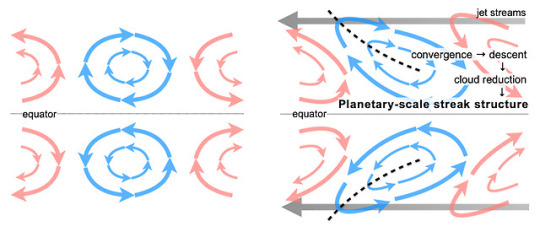
GIANT PATTERN DISCOVERED IN THE CLOUDS OF PLANET VENUS INFRARED CAMERAS AND SUPERCOMPUTER SIMULATIONS BREAK THROUGH VENUS' VEIL A Japanese research group has identified a giant streak structure among the clouds covering planet Venus based on observation from the spacecraft Akatsuki. The team also revealed the origins of this structure using large-scale climate simulations. The group was led by Project Assistant Professor Hiroki Kashimura (Kobe University, Graduate School of Science) and these findings were published on January 9 in Nature Communications. Venus is often called Earth's twin because of their similar size and gravity, but the climate on Venus is very different. Venus rotates in the opposite direction from Earth, and a lot more slowly (about one rotation for 243 Earth days). Meanwhile, about 60 km above Venus's surface a speedy east wind circles the planet in about 4 Earth days (at 360 km/h), a phenomenon known as atmospheric superrotation. The sky of Venus is fully covered by thick clouds of sulfuric acid that are located at a height of 45-70 km, making it hard to observe the planet's surface from Earth-based telescopes and orbiters circling Venus. Surface temperatures reach a scorching 460 °C, a harsh environment for any observations by entry probes. Due to these conditions, there are still many unknowns regarding Venus's atmospheric phenomena. To solve the puzzle of Venus's atmosphere, the Japanese spacecraft Akatsuki began its orbit of Venus in December 2015. One of the observational instruments of Akatsuki is an infrared camera "IR2" that measures wavelengths of 2 microns (0.002 mm). This camera can capture detailed cloud morphology of the lower cloud levels, about 50 km from the surface. Optical and ultraviolet rays are blocked by the upper cloud layers, but thanks to infrared technology, dynamic structures of the lower clouds are gradually being revealed. Before the Akatsuki mission began, the research team developed a program called AFES-Venus for calculating simulations of Venus's atmosphere. On Earth, atmospheric phenomena on every scale are researched and predicted using numerical simulations, from the daily weather forecast and typhoon reports to anticipated climate change arising from global warming. For Venus, the difficulty of observation makes numerical simulations even more important, but this same issue also makes it hard to confirm the accuracy of the simulations. AFES-Venus had already succeeded in reproducing superrotational winds and polar temperature structures of the Venus atmosphere. Using the Earth Simulator, a supercomputer system provided by the Japan Agency for Marine-Earth Science and Technology (JAMSTEC), the research team created numerical simulations at a high spatial resolution. However, because of the low quality of observational data before Akatsuki, it was hard to prove whether these simulations were accurate reconstructions. This study compared detailed observational data of the lower cloud levels of Venus taken by Akatsuki's IR2 camera with the high-resolution simulations from the AFES-Venus program. The left part of Figure 1 shows the lower cloud levels of Venus captured by the IR2 camera. Note the almost symmetrical giant streaks across the northern and southern hemispheres. Each streak is hundreds of kilometers wide and stretches diagonally almost 10,000 kilometers across. This pattern was revealed for the first time by the IR2 camera, and the team have named it a planetary-scale streak structure. This scale of streak structure has never been observed on Earth and could be a phenomenon unique to Venus. Using the AFES-Venus high-resolution simulations, the team reconstructed the pattern (Figure 1 right-hand side). The similarity between this structure and the camera observations prove the accuracy of the AFES-Venus simulations. Next, through detailed analyses of the AFES-Venus simulation results, the team revealed the origin of this giant streak structure. The key to this structure is a phenomenon closely connected to Earth's everyday weather: polar jet streams. In mid and high latitudes of Earth, a large-scale dynamics of winds (baroclinic instability) forms extratropical cyclones, migratory high-pressure systems, and polar jet streams. The results of the simulations showed the same mechanism at work in the cloud layers of Venus, suggesting that jet streams may be formed at high latitudes. At lower latitudes, an atmospheric wave due to the distribution of large-scale flows and the planetary rotation effect (Rossby wave) generates large vortexes across the equator to latitudes of 60 degrees in both directions (figure 2, left). When jet streams are added to this phenomenon, the vortexes tilt and stretch, and the convergence zone between the north and south winds forms as a streak. The north-south wind that is pushed out by the convergence zone becomes a strong downward flow, resulting in the planetary-scale streak structure (figure 2, right). The Rossby wave also combines with a large atmospheric fluctuation located over the equator (equatorial Kelvin wave) in the lower cloud levels, preserving the symmetry between hemispheres. This study revealed the giant streak structure on the planetary scale in the lower cloud levels of Venus, replicated this structure with simulations, and suggested that this streak structure is formed from two types of atmospheric fluctuations (waves), baroclinic instability and jet streams. The successful simulation of the planetary-scale streak structure formed from multiple atmospheric phenomena is evidence for the accuracy of the simulations for individual phenomena calculated in this process. Until now, studies of Venus's climate have mainly focused on average calculations from east to west. This finding has raised the study of Venus's climate to a new level in which discussion of the detailed three-dimensional structure of Venus is possible. The next step, through collaboration with Akatsuki and AFES-Venus, is to solve the puzzle of the climate of Earth's twin Venus, veiled in the thick cloud of sulfuric acid. TOP IMAGES....(left) the lower clouds of Venus observed with the Akatsuki IR2 camera (after edge-emphasis process). The bright parts show where the cloud cover is thin. You can see the planetary-scale streak structure within the yellow dotted lines. (right) The planetary-scale streak structure reconstructed by AFES-Venus simulations. The bright parts show a strong downflow. (Partial editing of image in the Nature Communications paper. CC BY 4.0 https://creativecommons.org/licenses/by/4.0/) LOWER IMAGES....The formation mechanism for the planetary-scale streak structure. The giant vortexes caused by Rossby waves (left) are tilted by the high-latitude jet streams and stretch (right). Within the stretched vortexes, the convergence zone of the streak structure is formed, a downflow occurs, and the lower clouds become thin. Venus rotates in a westward direction, so the jet streams also blow west.
4 notes
·
View notes
